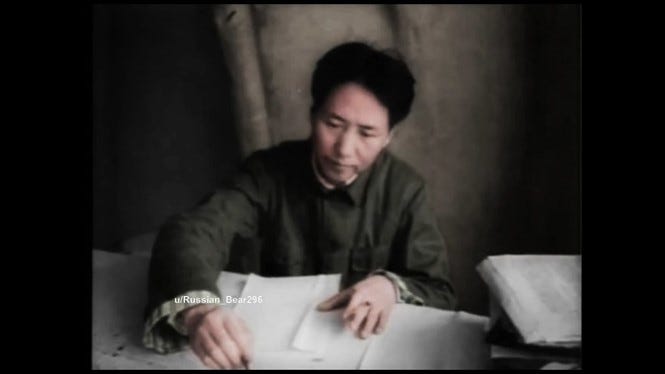Breaking through the Second ‘Encirclement’ [ Summer 1931]
[a tsu, to the melody of The Proud Fisherman, Yuchia Ao]
[translated by Nancy Lin]
Clouds rear above Paiyun Hill
As battle-cries intensify below.
Look! The stubs and stumps
Do stir and strive too!
Then forests of bayonets close in,
From beyond the skies
Winged hosts come swooping on the scene.
Seven hundred li in a fifteen-day drive:
Kan rivers with their hazy blue,
Ming hills in their jade green.
Facilely as mat-folding, the enemy hordes
Are by the thousand swept away clean.
Someone is weeping,
Vainly singing over his ‘fort at every step’!
Notes [by Nancy Lin]
Kan rivers refer to the various tributaries of the Kan River.
Ming hills means chiefly the Wuyi Mountain ranges around Chienning.
Someone weeping alludes ironically of course to Chiang Kai-shek’s lament of failure which cost him 10,000 dead and 30,000 captured.
Failing in his first attempt, Chiang was now adopting the strategy of ‘a fort at every step’. After establishing a battle front of 800 li from Chi-an eastward to Chienning in west Fukien, he began his second ‘encirclement’ operations in April 1931 under the slogan of cautious advance and gradual closing in.
Mao countered with his famous alternating tactics of evasion and surprise attack and succeeded in luring the enemy to Paiyun Hill, southeast of Chi-an, where the main Red forces had concentrated in ambush. Engagement took place on May 16, when a surprise frontal attack brought a break-through for the Red Army, followed by four successive quick battles to the north and then eastward to Kwangchang and Chienning – a 700 li drive in 15 days.
From Chienning, Mao at once set about extending new bases over that part of the Kiangsi-Fukien border in anticipation of Chiang’s next move.
next - 11. Tapoti]



